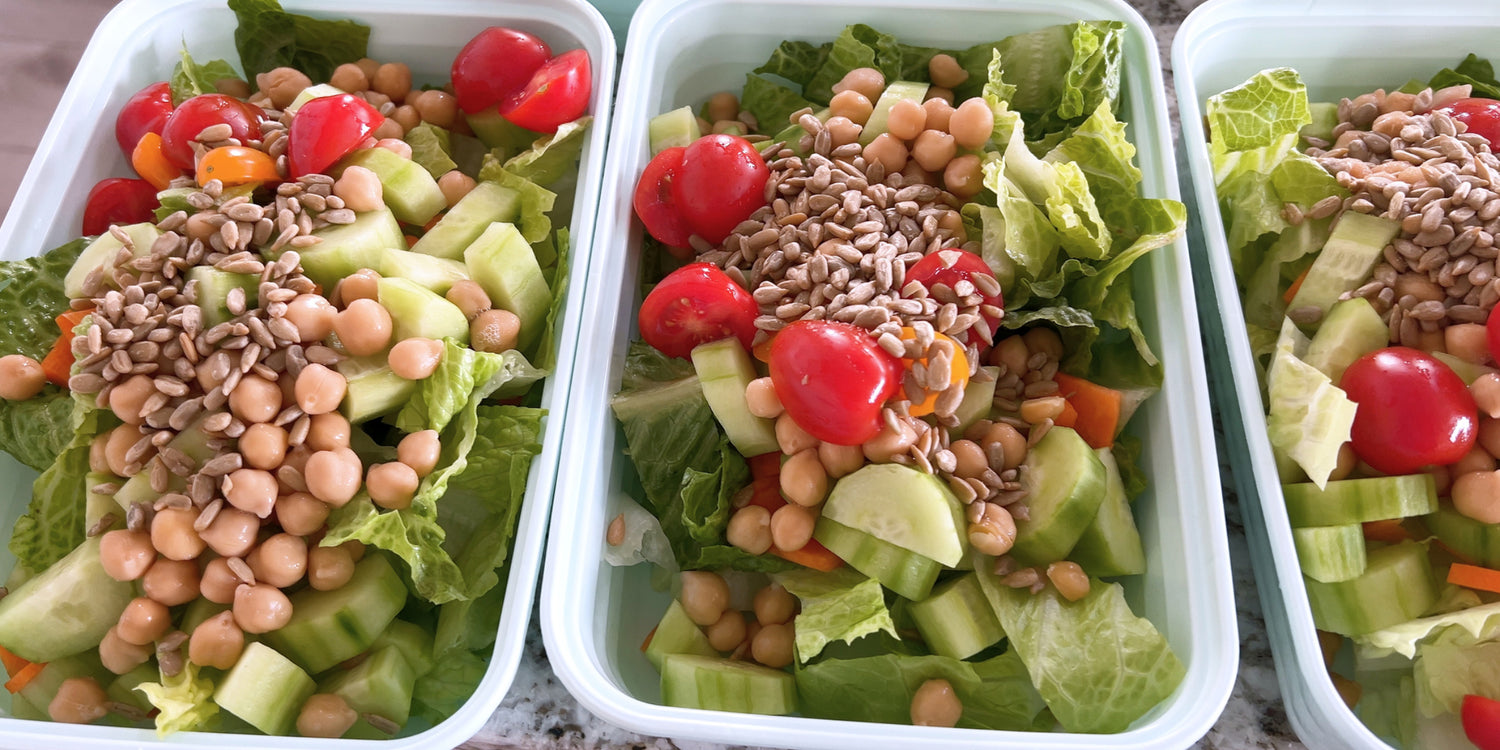In a world of oversized plates and super-sized meals, it's easy to forget what a healthy portion looks like. However, understanding portion control is essential for maintaining a balanced diet and achieving overall well-being.
So, let's learn more about the fundamentals of portion control and equip you with the knowledge and tools to make informed choices about the amount of food you consume. Whether you're looking to manage your weight, improve your energy levels, or simply adopt a healthier lifestyle, mastering portion control is a crucial step toward achieving your health or fitness goals.
Get ready to embark on a transformative journey toward mastering the basics of portion control. Let's dive in and discover the empowering world of food servings!
Why Is Portion Control Essential in Maintaining a Healthy Diet?

Portion control is essential in maintaining a healthy diet for several reasons. Firstly, it helps manage weight by preventing excessive calorie intake. When we consume larger portions, we tend to consume more calories than our body needs, which can lead to weight gain. By practicing portion control, we can ensure that we are consuming an appropriate amount of nutrients and energy for our bodies.
In addition, portion control plays a significant role in stabilizing blood sugar levels. Consuming large portions of high-sugar or high-carbohydrate foods can cause spikes in blood sugar levels, leading to energy crashes and potential long-term health issues such as diabetes. By controlling portion sizes and choosing balanced meals, we can maintain steady and healthy blood sugar levels.
Furthermore, practicing portion control improves digestion. Large portion sizes can overload our digestive system, leading to discomfort, bloating, and indigestion. By consuming smaller, controlled portions, we allow our digestive system to efficiently break down and absorb nutrients, promoting better digestion and nutrient absorption.
Lastly, portion control supports brain health. Overeating can affect cognitive function and impair concentration, as excessive food intake diverts blood flow from the brain to the digestive system, causing temporary sluggishness. By practicing portion control, we can ensure that our brain receives adequate blood flow and nutrients, supporting optimal brain function and mental clarity.
What Is a Serving Size?

Understanding serving sizes is an important aspect of maintaining a healthy diet. A serving size refers to the amount of food or drink recommended for consumption, as set by health experts. It provides a standardized measurement that helps individuals gauge the appropriate quantity of different food items they should consume. Serving sizes are crucial for accurate nutrient labeling on food products and are also used as a basis for dietary guidelines.
While serving sizes can vary depending on the food group and specific product, they are generally based on commonly consumed portions. It is essential to be aware of serving sizes as they play a significant role in controlling calorie intake, managing portion sizes, and making informed choices for a balanced diet. Being mindful of serving sizes enables individuals to monitor their food consumption more effectively and make healthier choices that align with their nutritional needs.
How to Determine Appropriate Serving Sizes for Different Foods?
When it comes to determining appropriate serving sizes for different foods, there are several methods one can use. One of the most common ways is by using scales or measuring cups. By weighing or measuring the food, you can accurately determine the serving size. This is especially useful for foods where portion sizes may vary widely, such as pasta or meat.
Another method is by reading food labels. Most food packages include information on the recommended serving size, which can help you understand how much of the food you should be consuming. Pay attention to serving sizes listed in grams or ounces, as this will give you a better idea of the actual amount.
It is also important to know the recommended serving sizes for commonly eaten foods. For example, a serving of grains, such as rice or pasta, is generally around 1/2 cup cooked. For fruits and vegetables, a serving is typically one cup. Understanding these general guidelines can help you make better portion choices.
What Is the Difference Between Portion Size and Serving Size?

The difference between portion size and serving size lies in their definitions and the purpose they serve. Serving size refers to the standardized amount of food used for nutritional information. It is typically determined by government agencies or food manufacturers to provide consistency and help individuals compare the nutritional content of different foods.
On the other hand, portion size refers to the amount of food one chooses to eat. It is often influenced by personal preferences, appetite, and individual needs. Portion sizes can vary widely from person to person based on factors such as age, gender, activity level, and overall health.
To illustrate the recommended serving sizes for commonly eaten foods, consider some examples. For pasta or rice, a standard serving size is typically around 75 to 100 grams. This amount provides a reasonable portion without overindulging in carbohydrates.
When it comes to vegetables, the recommended serving size is generally 1 to 2 cups. Including a variety of vegetables in your diet ensures you receive a good mix of essential nutrients.
In the case of cereal, a serving size is typically 1 cup. This measurement allows for a balanced breakfast portion that includes grains and can be adjusted depending on individual needs.
5 Easy Ways Control the Size of Your Portions

Controlling the size of our portions is an essential aspect of maintaining a balanced and healthy diet. By being mindful of how much we eat, we can avoid overeating and maintain a healthy weight. Additionally, portion control can help prevent health issues such as obesity, diabetes, and heart disease.
But by incorporating these five methods into our daily routine, we can take charge of our portion sizes and foster a healthier relationship with food.
-
Use Smaller Plates
Using smaller plates is a simple yet effective strategy for controlling portion sizes and preventing overeating. Research has shown that larger dinnerware can lead to consuming more food, as our perception of portion sizes is influenced by the size of the plate or bowl.
When we eat from a larger plate, we tend to underestimate the amount of food we are consuming. This can lead to overeating and ultimately contribute to weight gain. By using smaller plates, we can trick our minds into perceiving the smaller portion as more substantial, reducing the likelihood of overeating.
A smaller plate makes the food portions appear larger, creating a visual illusion that satisfies our hunger cues. It effectively limits the amount of food we can fit on the plate, helping us control portion sizes without feeling deprived.
To practice portion control effectively using smaller plates, it is essential to follow a recommended portion guide. Fill half of the plate with non-starchy vegetables like leafy greens, broccoli, or cauliflower. One-quarter of the plate should be dedicated to lean proteins such as chicken, fish, or tofu. The remaining quarter can be filled with carbohydrates like whole grains, beans, or sweet potatoes. This way, we can ensure a well-balanced meal while still controlling portion sizes.
-
Avoid Eating Directly from Food Packages
When it comes to achieving and maintaining a healthy weight, portion control is key. By being mindful of the amount of food we consume, we can prevent overeating and unnecessary weight gain. One simple yet effective way to practice portion control is by avoiding eating directly from food packages.
When we eat directly from food packages, it becomes easy to lose track of how much we are actually consuming. We tend to mindlessly eat and may end up eating far more than what is necessary for our bodies. By transferring snacks onto a plate or into a bowl, we bring a heightened awareness to our food intake. This simple act allows us to visually assess the quantity of food we are about to consume, making it easier to moderate and control our portions.
Another habit to cultivate is re-portioning family meals onto individual plates before serving. This allows each person to have a controlled portion, preventing the temptation to go back for seconds or consume oversized servings. Additionally, by serving meals onto plates, we can take the time to appreciate the presentation and savor each bite, promoting a more mindful eating experience.
By avoiding eating directly from food packages and instead transferring snacks onto a plate or re-portioning family meals onto plates, we can increase our awareness of portion sizes and prevent overeating. This practice promotes healthier eating habits and helps maintain a balanced diet, contributing to overall well-being and weight management.
-
Measure Your Portions Using a Food Scale
One effective method for controlling portion sizes is to measure your portions using a food scale. This ensures accurate measurements and enables you to track your calorie and nutrient intake more precisely. The process of measuring portions using a food scale is simple and involves a few steps.
First, choose a reliable food scale that can accurately measure the weight of different food items. Place the scale on a flat and stable surface in your kitchen, ensuring it is easily accessible.
Next, place a clean plate or bowl on the scale, making sure it reads zero grams or ounces before adding any food. This ensures that the weight of the plate or bowl is not included in the final measurement.
Now, add the desired food item to the plate or bowl, taking care not to overload it. As the food is added, the scale will display the weight of the portion in grams or ounces. Continue adding or removing food until the desired weight is reached.
Using a food scale for portion control offers several benefits. Firstly, it allows for accurate measurements, ensuring you are consuming the intended portion size. This is particularly important for those trying to manage their calorie intake or follow a specific diet plan.
Additionally, measuring portions with a food scale helps develop a more realistic understanding of portion sizes. This can lead to better portion control habits and a more balanced diet overall.
-
Drink a Glass of Water Before Meals
Drinking a glass of water before meals is a simple yet effective strategy for portion control and weight loss. This practice holds significant significance due to its impact on reducing calorie intake. By incorporating this habit into our daily routine, we can achieve our weight loss goals more easily.
Several studies have supported the idea that drinking a glass of water before meals aids in weight management. One study conducted at Virginia Tech found that individuals who drank 16 ounces of water before their meals consumed fewer calories during their meal compared to those who did not consume water beforehand. This reduction in calorie intake can be attributed to water's filling nature, which helps to create a sense of fullness, thus reducing the amount of food we consume.
By drinking a glass of water before our meals, we can control our portion sizes more effectively. Water takes up space in our stomachs, curbing our hunger and preventing overeating. Furthermore, water has no calories, making it an ideal tool for calorie control.
-
Take It Slowly
To take it slowly while eating a meal and truly benefit from the experience, it is important to focus on the meal and refuse to rush. By doing so, not only will you be able to enjoy your meal to its fullest, but you will also be able to control portion sizes and make healthier choices.
To begin, find a calm and quiet environment where you can sit comfortably without any distractions. Take a few deep breaths to relax and shift your focus solely onto your meal. Avoid eating while working, watching TV, or using electronic devices, as these distractions can cause mindless overeating.
Next, take small bites and chew your food thoroughly before swallowing. Savor each bite, noticing the flavors, textures, and aromas. By thoroughly chewing your food, you will not only enhance the taste and enjoyment, but also give your brain time to register the feeling of fullness. This will prevent you from overeating and help control portion sizes.
As you eat slowly, pay attention to your body's hunger and fullness cues. As soon as you start to feel satisfied, stop eating, even if there is still food on your plate. This will prevent overeating and allow you to have a better understanding of your body's needs.
In addition to controlling portion sizes, eating slowly has numerous benefits. Firstly, it increases feelings of fullness, as the brain has more time to register the signals from the stomach, resulting in consuming fewer calories overall. Secondly, it can decrease food intake, as slower eating promotes mindful choices and helps you to recognize when you are truly hungry or simply seeking emotional comfort. Lastly, eating slowly enhances the pleasure of the meal, allowing you to fully savor each and every bite, which can also reduce the desire for second helpings.
Takeaway
Understanding portion control is vital for maintaining a healthy diet in a world of oversized plates and super-sized meals. By mastering portion control, individuals can manage weight, stabilize blood sugar levels, improve digestion, and support brain health. Incorporating strategies like using smaller plates, avoiding eating directly from food packages, measuring portions with a food scale, drinking water before meals, and eating slowly empowers individuals to make informed choices about their food intake, leading to a balanced diet and healthier lifestyle. By being mindful of portion sizes and practicing mindful eating, individuals can prevent overeating and foster a healthier relationship with food, ultimately promoting overall well-being.
Renpho Health Tips
-

Gamification: Leveling Up Your Fitness Motivation
April 29, 2024
Read more >
-

Fueling Your Body Right: How to Cultivate Proper Eating Habits
April 18, 2024
Read more >
-

The Gallbladder Diet: Foods to Feast on and Foods to Avoid
April 12, 2024
Read more >
-

Top 5 Diet Tweak Tips for Healthier Gut
May 9, 2023
Read more >
-

Gut Check: Prebiotics and Probiotics Explained
May 16, 2023
Read more >

